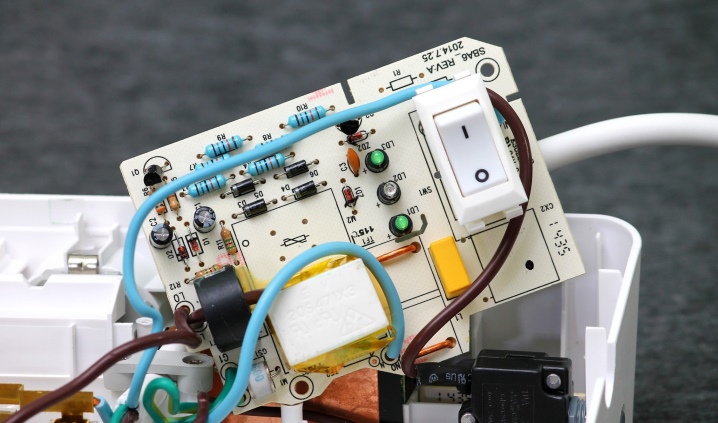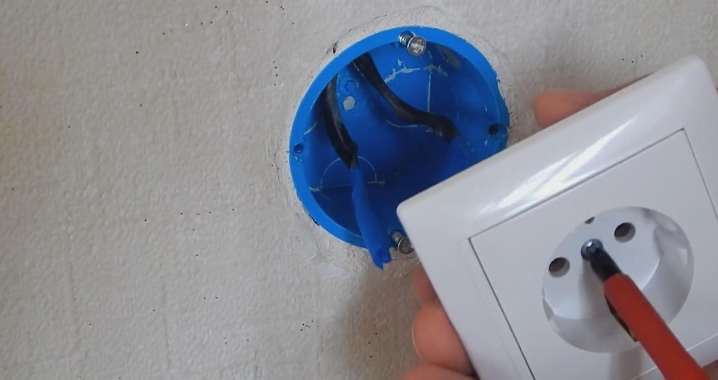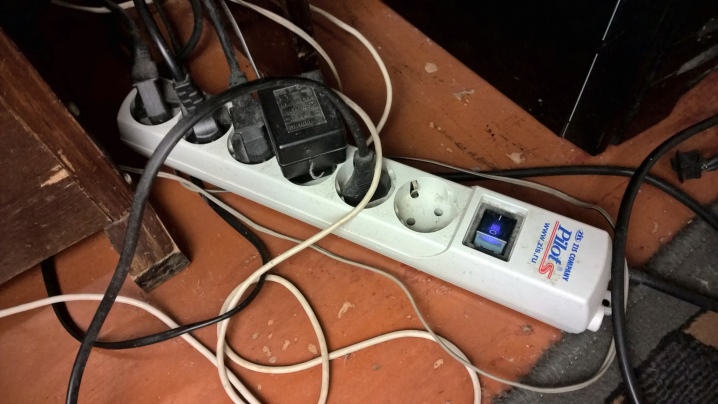All about repairing surge protectors

Even the highest quality electrical appliance requires repair over time. Surge protectors are no exception. Over time, such malfunctions arise that raise questions: why the button does not turn on, is the fuse working? All about the main causes of breakdowns, and how to disassemble the riveted filter with your own hands, read the article.



Major malfunctions and their causes
In working order, the power cord must protect the connected devices from voltage surges; for this, a fuse is installed in it.
When the fuse is on, an indicator light comes on next to it, indicating that it is ready for use and is working as it should.

But sometimes there are problems that become noticeable only during operation. All reasons can be roughly divided into two points:
- violation of the physical integrity of external parts (cable, button, sockets or plug);
- combustion of the internals of the pads (tracks on the printed circuit board, automatic thermal fuse, switch contacts).
If the extension cord starts to fail, which may be evidenced by uncharacteristic crackling, sparking or blinking of the LED, then it must be replaced or disassembled immediately.
It is strongly discouraged to use a broken filter, because the very first power surge can burn all the expensive equipment that is connected to it.


The difference between the mains filter and the extension cord is in the presence of a varistor that protects against voltage surges and short circuits, an LC filter against high-frequency interference.
The device is a plastic case with outward-facing sockets (sockets) for Euro plugs. Contact plates sometimes deform if they are made of low-quality cheap metal, which leads to backlash and signal cutoffs. In addition, the plug itself heats up, which often leads to its burnout, plastic may melt and even a short circuit and fire may occur.

How to disassemble correctly?
Disassembling a conventional Pilot filter begins with unscrewing the screws, as, indeed, in most other cases, but in some non-separable models, the body may be without bolts on riveted screws. Usually the fasteners are installed on the back, they are often covered with factory stickers, but they can also be found in the front, right in the grooves of the sockets. For additional fixation, there are plastic latches at the junction of the two halves of the case. When opening, you must not make sudden movements and use force so as not to disrupt the structure. If the device has never been disassembled, there will be a warranty seal on the case.


Fixed screws can only be unscrewed using "barbaric" methods using a soldering iron or a drill and pliers. In this case, the appearance will be irretrievably damaged.
You can try to stick out only the button with a flat screwdriver, because in such devices, most often the contacts in the switch are clogged with dust, or the cord itself breaks.
Further, using the tool, you carry out diagnostics and repair of units. You will need:
- soldering iron;
- screwdriver (cross and flat);
- tester;
- file or sandpaper;
- tweezers;
- a hairdryer for blowing out after cleaning the contacts.



The search for defects is necessary in order to make a final conclusion about the possibility of its repair and the feasibility of further use. ANDSometimes the price of the issue is only 200 rubles, so it makes little sense to fix the breakdown, but if the filter was powerful, with a reusable fuse, then the cost of such a device can be several times higher.

Can it be repaired?
Depending on the cause of the breakdown, surge protectors are quite suitable for repair, the main thing is to have at least a little experience with a soldering iron and a screwdriver. Before starting, carefully inspect the outside of the instrument. Sometimes, in order to fix it, you don't even have to disassemble it - it will be enough to change a burnt out or broken plug. TOWhen there are no external signs of breakdown, but under load it emits strange sounds, then most likely it is the choke (pulse voltage absorbers in the form of a coil) cracking.
In general, the repair of the surge protector is possible, the main thing is to find the exact cause of the breakdown and correctly eliminate it.
When you need to change the fuse, this is also not a problem. If the button does not work when turned on, the backlight does not light up, it is also not necessary to solder it right away - you can simply pull the switch case out of the socket, clean the contacts and carefully put it back in place.

The button does not turn off
If the fuse has blown, then the button (the one without the LED, apart from the "on / off") stops pressing and constantly sticks up, which means emergency mode without electricity. It is enough to evaporate or unscrew it (depending on the model) to take it to the radio parts store, where the seller will pick up exactly the same one. It happens that the desired model is not on sale - it's okay, you can connect the wires directly with your own hands without buttons. Then, instead of a surge protector, you will have an excellent extension cord, which is quite useful for charging low-voltage appliances, lamps and radios.

The light is flashing
The power switch button can spontaneously turn off or completely jam in the "on" position. Sometimes the power indicator starts flashing for some unknown reason. This also suggests that, most likely, it's time to clean the contacts. After disassembling the case, you need to remove everything that covers the button, unscrew the screws from the printed circuit board (to turn it over), or unsolder the power cable and button legs. After that, the switch box can be pulled out and, using a flat screwdriver, unhooked the latches that hold it in the socket.


There is a connection diagram on the button body so that you can assemble everything in the correct sequence.
Inside there are contacts made of spring steel. Over time, they become covered with a layer of carbon and oxide, so the contact point begins to heat up more than usual. If you clean them with sandpaper or a file, the button will stop overloading and shutting down. At the end, you can treat the stripping points with alcohol and blow out, and then assemble the switch and solder it back.

Sparkles
If the surge protector sparks when turned on, then this indicates, rather, a violation of the insulation of the internal contacts, than that some part has broken. Look inside, check and, if necessary, ring out with a tester where the wires could have gone. If you find it, take more solder, because cheap Chinese factories often sin with indecently flimsy soldering quality and savings on literally everything, including tin.
Keep in mind that sparks and popping can occur not only due to a defect in the surge protector, but also due to a weak outlet that is not designed for heavy loads. To check, find a good outlet or disassemble an existing one (after de-energizing it) for problems with twisting in reconnaissance boxes (especially for Soviet aluminum ones).

Other breakdowns
Mechanical damage to the breaker latches due to breakage and melting of the plastic is also possible. In this case, a hole is carefully drilled in the button body and a cotton swab or toothpick is inserted, acting as a latch that is inserted into the groove. After these simple manipulations, you can return the switch to its place.The line filter is ready for use again!
In general, the most common breakdown is considered to be a violation of the integrity of the cable due to constant bends. You need to ring the cord with a multimeter for circuit integrity.
If there is no voltage, then look for the designation of the cross-section mark on it and buy a replacement of the required length. Next, you should disassemble the plug and case and solder the wires to the contacts, not forgetting to first clean them and insulate them after soldering.

Recommendations
If you have already decided to disassemble the filter, then at the same time check all other components for serviceability. Quite often, it is not the fuses and buttons that fail, but the varistor, which is also needed to protect the outgoing lines from overvoltage.
Many do not know the rules for operating surge protectors and connect them to uninterruptible power supplies, which leads to breakdown of protective circuits. Also, you cannot connect the filters to each other, because the series connection will multiply the current in the ground phase, and the voltage power will increase above 3.5 kW. This applies specifically to devices with filters, and not just extension cords with a power button.
Besides, it is very undesirable to connect devices with high input voltage to simple models - not only will this not save them from burnout, it will also quickly disable the filter itself.

How to repair a surge protector, see below.













The comment was sent successfully.